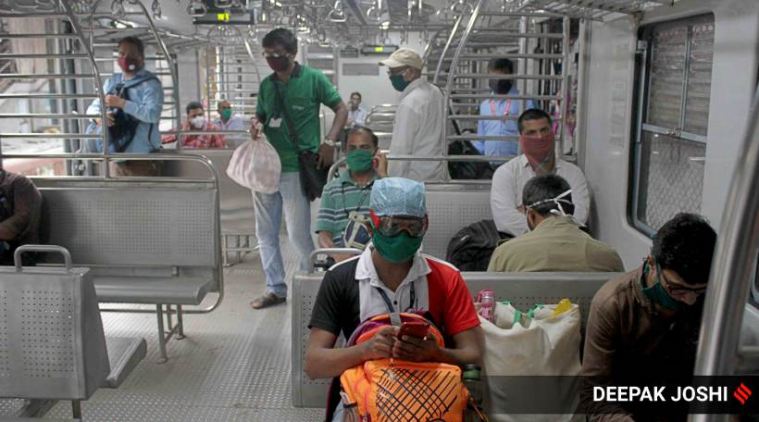, Edited by Explained Desk | Mumbai |
Updated: September 30, 2020 3:15:32 pm
Mumbai’s suburban trains are purposeful but overcrowded. During peak hours, a nine-car train, which can take 1,700 passengers, used to carry 5,000 passengers(File/Express Photo: Amit Chakravarty)
It has been over six months since Mumbai’s suburban train services, the lifeline of the metropolis, were drastically curtailed as part of the nationwide lockdown imposed as a reaction to the spread of the Covid-19 pandemic. With another phase of Unlock guidelines expected for October, we explain the importance of Mumbai’s purposeful suburban train system and the reasons why there is a growing demand for resumption of its normal services.
Why the local train service is important to Mumbai
For a linear city like Mumbai, the suburban train services played a vital role in facilitating the north-south movement of the city’s workforce. The two suburban systems operated by both Western Railways and Central Railways stretches 319 km. It facilitates the inter-district travel of commuters in five districts namely Mumbai, Mumbai Suburban, Thane, Palghar and Raigarh.
How many people use the suburban train services
The Central Railways used to operate 1,774 services while the Western Railway would operate 1,367 services each day before the pandemic. These services operate on an average frequency of around one every four minutes ferrying around 7.8 million commuters per day.
How many train services are running now?
Suburban train services were shut down on March 23 during the lockdown. The partial resumption of services was announced on June 15, but only those deemed to be essential service providers were allowed to board these trains after being allotted a special pass.
 The partial resumption of services was announced on June 15 for those deemed to be essential service providers (File/Express Photo By Deepak Joshi)
The partial resumption of services was announced on June 15 for those deemed to be essential service providers (File/Express Photo By Deepak Joshi)
However, both the divisions are not operating local trains to its full capacity. WR is operating at 37 per cent capacity running 506 of its 1,367 services, while Central Railways is operating at 24 per cent capacity operating 423 of its 1,774 services. Currently, only government employees and essential services providers are allowed to use local trains.
The state, however, makes case by case exceptions allowing students who had to give exams to board the trains. On the directives of the Bombay High Court, lawyers attending physical hearing of cases in the principal seat of the HC in Mumbai were also allowed to board trains.
📣 Express Explained is now on Telegram. Click here to join our channel (@ieexplained) and stay updated with the latest
What has been the impact of shutting train services for common public
The Maharashtra government decided against resuming full service of the suburban trains to prevent “non-essential” travel out of concerns that gains made by Mumbai in the fight against coronavirus may be reversed if commuters crowd into trains.
However, the decision to regulate the service on the nation’s largest commuter train network has caused hardships to many residents of Mumbai’s satellite cities, especially the poor. As businesses open, many of the city’s workforce who stay in far away locations from commercial business districts in the city have seen their daily commute time double as they attempt to reach Mumbai.
In some cases commuters from satellite suburbs like Vasai, Virar, Panvel, Kalyan spend over four hours one way to reach their places of work. The cost of commuting has also increased substantially. While a 67-km commute on the suburban line would cost only Rs 35, commuters now spend anything between Rs 200-300 to cover the same distance by road. There have been protests and demonstrations in these places seeking the resumption of normal train services.
What are the dangers of reopening Mumbai’s suburban train services?
Mumbai’s suburban trains are purposeful and punctual, but they are also overcrowded. During peak hours, a nine-car Mumbai suburban train, which can take 1,700 passengers (about 4 persons per square meter), has been carrying 5,000 passengers, (about 12 persons or even 14 to 16 passengers per square meter, which is defined as super dense crush load by Indian Railways). There is a fear that allowing resumption of normal services increases the chances of the infection spreading. A Covid-19 projection model by Tata Institute of Fundamental Research (TIFR) had warned that if local trains are restarted by mid-September, it may lead to a ‘difficult to manage’ second wave. The model has advised staggering of office timings to avoid overcrowding in trains.
Will normal services resume anytime soon?
There has been increasing pressure from the general public as well as public representatives on allowing the resumption of normal train services. BJP MP Manoj Kotak had raised the issue in parliament demanding the resumption of train services for all for the convenience of a large number of people who have to report to work and travel within the city. Mumbai Guardian Minister Aditya Thackeray has given an indication that there could be some normalisation of services by mid-October. However, with the Covid-19 numbers increasing in Mumbai, the Uddhav Thackeray government has indicated that it will take a cautious approach on restarting services.
📣 The Indian Express is now on Telegram. Click here to join our channel (@indianexpress) and stay updated with the latest headlines
For all the latest Explained News, download Indian Express App.
© The Indian Express (P) Ltd
Source: https://indianexpress.com/article/explained/restarting-mumbais-sub-urban-trains-covid-19-unlock-6633611/


